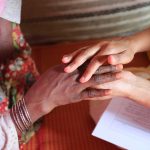Dr. Parveen Parmar is a PHR expert and chief of the Division of International Emergency Medicine and associate professor of Clinical Emergency Medicine at the University of Southern California’s Keck School of Medicine. A longtime consultant to PHR on the persecution of minorities in Myanmar, Dr. Parmar travelled with a PHR team to Bangladesh in 2017 and 2018 to document the injuries suffered by Rohingya refugees driven out by Myanmar authorities. She had previously conducted a PHR population-based study of residents of Chin State, Myanmar, which quantified the prevalence of human rights violations inside Myanmar and was presented widely in the international community. PHR sat down with Dr. Parmar following her recent trip.
How did you become interested in human rights advocacy?
Both my maternal and paternal family survived the partition of India and Pakistan in 1947. Our family left their homes and all their belongings to travel to a newly formed nation under constant threat of violence. Members of my family at one point had to hide under dead bodies to avoid getting shot during the flight from Pakistan to India.
I was eight years old when I visited my father’s village for the first time. Now when I see displaced Rohingya families, I think my family must have looked much the same, in camps along the newly formed India border. I’m reminded that we are fundamentally no different than them.
During high school I first became active in human rights, enrolling in a chapter of Amnesty International. As a medical student at Northwestern University, I started a student chapter of Physicians for Human Rights and instituted a course about health and human rights. Injecting human rights education into my medical school curriculum allowed me to connect with truly inspiring activists — and inspired me to continue to engage in human rights work after medical school.
How do you bring human rights into your medical career?
Some may see human rights work as outside the realm of a traditional medical work – but I think all physicians have a responsibility to protect their patients. We have to comment on the things that we see affecting the health of our patients and the health of people around the world.
My first project with PHR involved helping identify human rights violations in Chin State, Myanmar. We trained 15 talented community health workers from Chin State to administer a population-based survey. They found that 92 percent of the households they surveyed had suffered from forced labor. We were able to report these findings on hard-to-reach populations to several international agencies, including UN actors, thanks to the courage of the Burmese health workers. We had planned a similar survey for Rakhine state in Myanmar, but the level of repression there was so severe that it was impossible. Instead, we conducted a brief nutrition assessment among Rohingya refugees in Bangladesh that found high levels of malnutrition, pointing to the extreme hardships they had experienced before fleeing Myanmar. What has frustrated me since doing that work is the dramatic deterioration of the conditions Rohingya face, and for that reason I am dedicated to advocating on behalf of the Rohingya with PHR.
Why did you join PHR’s recent trips to Rohingya refugee camps in Bangladesh?
There was never a question that I wouldn’t join this trip. This is without a doubt the worst situation I’ve seen in my human rights career, and it must be addressed. In my research supporting health programming in crisis settings, my ability to advocate can be limited. Highlighting abuses can put the organizations I support in jeopardy. Physicians in settings similar to mine see atrocities regularly. PHR gives practitioners the ability to use science to advocate for the populations we serve and to help address the root causes of the suffering they face.
What are some challenges you’ve met in your career?
I’ve seen countless situations where politics have taken priority over human life, and where someone’s legal status, ethnic or religious background has prevented them from living a safe and healthy life. This is a reality of our world I still have a hard time accepting—and it’s an area I hope to play a small part in addressing during my career.
The work can also be challenging personally. Secondary trauma is a real phenomenon. It’s important to let other people know what I saw and the trouble I have forgetting it. Thankfully friends, colleagues, and family are very supportive. Young advocates should recognize that this is a real aspect of their work and find avenues for self-care.
How do you hope this work contributes to a solution to the Rohingya crisis?
Talk about a possible repatriation of the Rohingya to Myanmar just months after the atrocities were perpetrated against them deeply concerns me, especially since there’s been no discussion of citizenship for the Rohingya or accountability for those that have hurt them.
What’s more, the narrative that the atrocities the Rohingya have faced is “fake news” still exists. It’s particularly horrifying to see this harmful U.S.-based narrative co-opted by human rights violators abroad. The forensic evidence and Rohingya refugee stories that PHR is collecting can be used to counter that narrative—and I hope will ultimately lead to justice and safety for the Rohingya.

